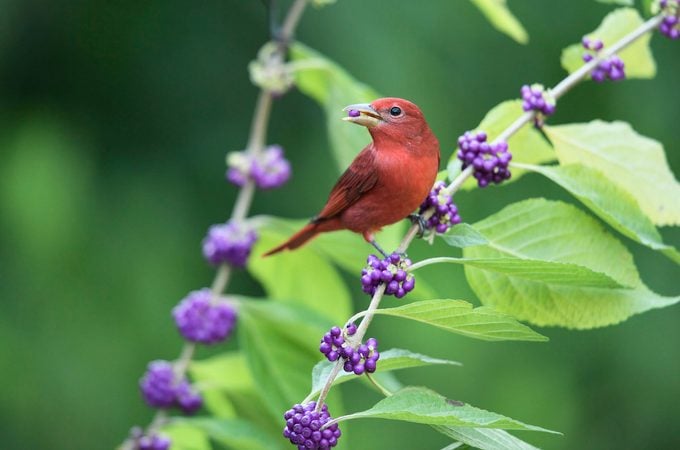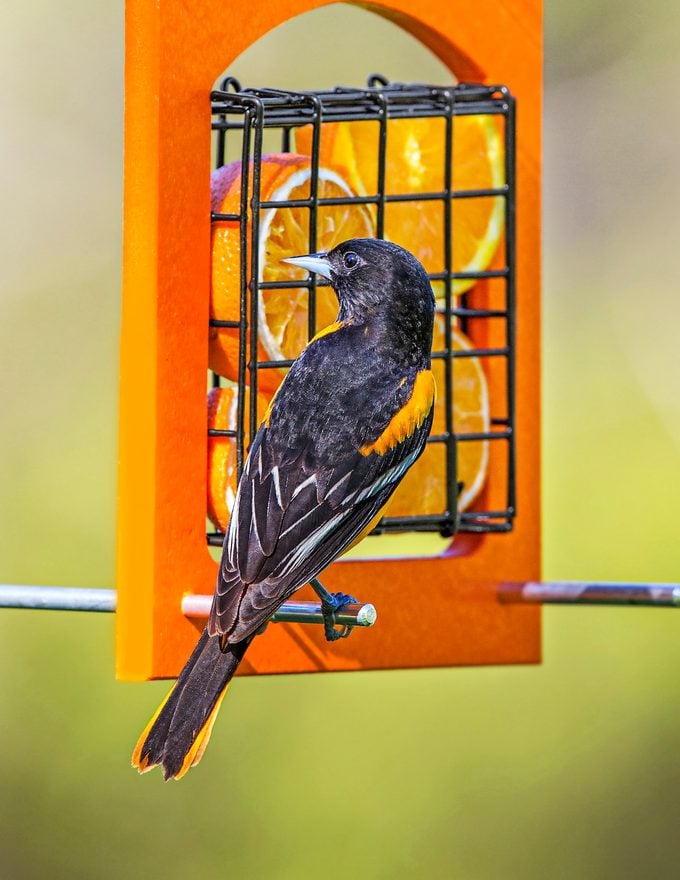How to Attract Birds: Offer Food, Water and Shelter
Updated: Dec. 14, 2021
Follow these simple tips to make your yard a dream destination for birds. Learn how to attract birds by fulfilling all of their essential needs.
Our editors and experts handpick every product we feature. We may earn a commission from your purchases.
To turn your yard into a year-round destination for your feathered friends, zero in on their biggest three needs: food, water and shelter.
Think Beyond Feeders
Common bird species like chickadees and goldfinches readily visit feeders, but many others don’t. “While feeders do provide a great resource, especially in colder climates where birds may have a hard time accessing food in the winter, they don’t feed all birds,” says Becca Rodomsky-Bish, a project leader with the Cornell Lab of Ornithology. “More than 90 percent of North American songbirds need insects to raise their young.”
Check out the 10 types of bird feeders you need in your backyard,

Provide Natural Food Sources
A good habitat includes plants to provide natural sources of berries, seeds and nectar. You’ll also want plants that draw insects. Choose native plants, shrubs and trees for your backyard habitat to maximize the benefits for feathered visitors. Most berries ripen in the fall, just when birds are undertaking arduous migrations that require lots of sugar-fueled energy.
Native wildflowers bring in hummingbirds in warmer months, plus insects that provide much-needed protein. Check out these colorful flowers that hummingbirds love!
To find the best choices for your yard, shop at native plant nurseries or consult your local county extension office.
Offer Water in a Bird Bath
Wonderful wildlife habitats supply birds with plenty of water for drinking and bathing. Lakes, ponds and streams are the best natural resources, but bird baths are a good substitute. Be sure to keep birdbaths clean and provide fresh water regularly.
Birds prefer moving water, so think about adding a solar-activated water agitator to your bird bath. In colder climates, experts suggest heated baths to keep the water from freezing. This will also draw flocks when temperatures drop and open water is hard to find.
Grow Shrubs for Shelter
If you’re wondering why you don’t see many birds at your feeders, lack of shelter could be the problem. Birds need protected spaces to raise their young, hide from predators and take cover during bad weather. Feeders without nearby shelter can actually endanger birds, making them vulnerable to hawks and other predators while they eat. Plant shrubs or trees to give birds a convenient place to hide if danger threatens.
Learn how to create winter shelter for birds.

Provide Birdhouses
If you truly want your yard to be a gathering place for feathered families, birdhouses and nest boxes are essential additions. Becca emphasizes that it’s important to make smart decisions based on the visitors most commonly seen in your area. “Nest boxes help to replace the snags or standing dead trees that are frequently removed from neighborhoods or properties,” she says.
Different species have different requirements, including hole size, box depth and placement. She recommends using NestWatch’s Right Bird, Right House online tool to find the perfect box for your local nesters. Or check out this birdhouse hole size chart.
You can also get creative by following these instructions to make a purple martin birdhouse out of a gourd!
Get more tips on how to attract birds to a birdhouse.
Check Your Yard for Hazards
Building a backyard habitat brings great pleasures, but there are also great responsibilities. “When you invite birds in, make sure you protect them once they arrive,” Becca advises. “While we don’t want to discourage habitat creation, it is important to ask yourself if you are really helping the birds if, once they show up, there are dangerous obstacles that could threaten them.”
Feeders that are low to the ground may accidentally turn visitors into easy prey for ground-based predators, such as outdoor cats. Those feeders can also attract nuisance animals like raccoons, which may stick around and snack on eggs in nearby nests, too. Hang feeders high and use baffles to deter predators. Keep your cats indoors—and urge your neighbors to do the same.
Check out 5 ways to create a bird-safe backyard.
Prevent Window Strikes
Windows are another major issue. The American Bird Conservancy estimates as many as one billion birds are killed in window collisions each year. They recommend adding decals, paint, tape or screens to make windows safer. Here are more tips for preventing bird strikes.

How to Learn More About Birds
As more avian species begin to call your backyard home, take time to learn about each bird using field guides and websites. Pick up a pair of binoculars so you can see feeder guests more clearly, or invest in a good camera and take up wildlife photography. Share your observations using online programs like FeederWatch or the Great Backyard Bird Count.
Backyard birding is a worthwhile and relaxing hobby, and making a few simple adjustments can turn any landscape into a must-stop location for avian visitors.
Get more tips on bird-watching for beginners.




















